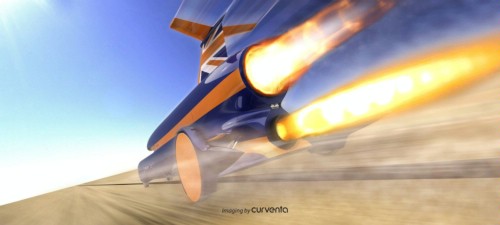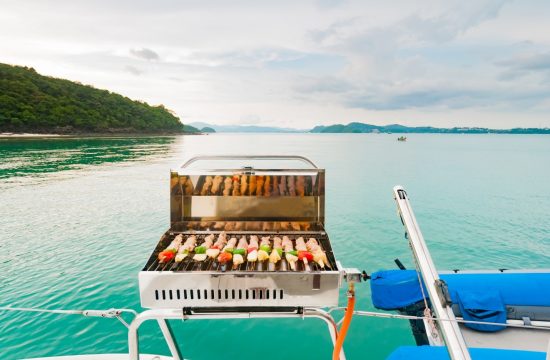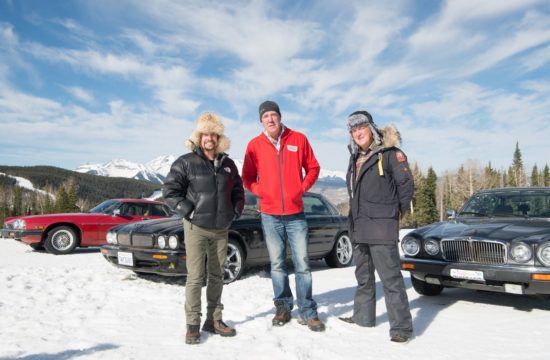After a year the British BLOODHOUND rocket powered car project is shaping up pretty nicely. The SSC (Super Sonic Car) is going to break the land speed record by doing more than 1000mph! (1600+ km/h). Achieving major milestones, the team has even picked the site in which they are going to do this. It’s a 12 mile-long track across a perfectly flat dried-up lake bed in Hakskeen Pan, Northern Cape province, South Africa. Bloodhound’s rockets develop the equivalent of 135,000 HP!!!
Hit the jump for more details on the car…

Press Release:
1,000 mph car: The Adventure Builds
One year on – major milestones achieved
The BLOODHOUND Project is the World Land Speed Record attempt designed to inspire young people to pursue careers in science, technology, engineering and mathematics (STEM subjects).
The Project, sponsored by fuel additives and engine care brand, STP, was launched in October 2008, and today announces six major milestones:
1. Education: 2,410 schools sign up to the BLOODHOUND Education programme; independent research confirms BLOODHOUND SSC is having a mini “Apollo” effect
2. Car design finalised: BLOODHOUND SSC has gone through ten design evolutions. The design is now set with the EJ200 jet engine from a Eurofighter Typhoon positioned above the prototype hybrid rocket – the largest ever designed in the UK
3. Launch of new BLOODHOUND HQ: New BLOODHOUND Headquarters and build site opens in Bristol Docklands
4. Record attempt: Runs to commence in 2011 on the Hakskeen Pan, Northern Cape Province, South Africa
5. Sponsors: Major sponsors supporting the Project include STP, Lockheed Martin and IT partner Intel
6. Supporters’ club: raised over £137,000 in it’s first year
1. The BLOODHOUND Education Programme
The Project has over 2,410 primary and secondary schools, 178 further education colleges and 33 universities signed up and using the BLOODHOUND Education resources in their lessons. We have reached our target of 10% of the 25,000 schools in the England and Wales in the first year alone – the Project has even had its first nursery school join this week.
An independent study by the National Foundation for Educational Research (NFER) concluded that the BLOODHOUND Education Programme provides a genuine ‘hook’ to get children interested in science and engineering.
Siobain Barns from Harwood Meadows Primary School in Bolton, who uses the resources in her classroom, said: “Our pupils are blown away to be involved in such an exciting project and enthusiasm is equally high from girls as well as boys” she continued: “They’re enjoying maths without realising they’re learning.”
Its not just at primary level that BLOODHOUND Project is having an effect. The University of the West of England and Swansea University, both Project sponsors, have seen increases in student applications for their undergraduate engineering and computing courses of 37% and 32% respectively.
2. Car design finalised and construction begins in Bristol
BLOODHOUND SSC (Super Sonic Car) has gone through ten design evolutions since work started. The original plan had been to position the small 200 kg rocket above the heavier 1,000 kg EJ200 Eurofighter Typhoon jet engine and the car was designed accordingly over the following 18 months. As the Project developed it became clear that more thrust was required to overcome the aerodynamic drag. This culminated in a hybrid rocket weighing 400 kg. The extra thrust also created a fresh challenge for the engineering team: The rocket firing would violently pitch the car nose-down, de-stabilising the whole vehicle.
The engineering team lead by John Piper, engineering director, began a radical re-design of the car which saw the jet engine positioned over the rocket. This re-design was made possible by IT partner Intel providing one of the largest computer clusters in the country. Designs are tested using Computational Fluid Dynamics (CFD) technology developed at Swansea University. Tests that previously took one day to be run could now be completed in just a couple of hours with the increase in computing resource provided by Intel.
Cockpit design
The world’s fastest office has been designed by driver Wing Commander Andy Green, based on his experience flying fighter jets and on the cockpit of his previous World Land Speed Record car Thrust SSC.
Images are available on our FTP site, details below.
Wheel design
Lockheed Martin UK has been developing the BLOODHOUND SSC wheel design to ensure they can withstand forces of 50,000 radial g at the rim and support a 6.5 tonne car travelling at 1,050 mph. Research by Lockheed Martin UK has focused on a 90 cm diameter wheel design, constructed from forged aerospace-grade aluminium.
BLOODHOUND SSC rocket test programme
BLOODHOUND SSC will feature the largest hybrid rocket ever designed in the United Kingdom. The rocket weighs in at 400 kg, it is 45 cm (18 inches) in diameter and, at 425 cm (14 feet) long, the same length as a Formula One car. The rocket is designed to produce 122 kN (27,500 lbs) of thrust. Together with BLOODHOUND SSC’s EJ200 jet engine (90 kN/20 000 lb thrust), this will give the car a total of 212 kN (47,500 lb) of thrust – the equivalent of 135,000 HP, or the power of 180 Formula One cars.
On Saturday 17th October a team of experts, led by 25 year-old rocket engineer Daniel Jubb, successfully fired the first 45 cm (18 inch) prototype rocket in the Mojave desert, USA. This marks a major milestone in the rocket development programme, progressing from 15 cm (6 inch) rockets, which are regarded as world-class by the rocket community.
3. BLOODHOUND HQ opens in Bristol
The BLOODHOUND Project has a new HQ in Bristol’s docklands, right next door to SS Great Britain. The BLOODHOUND Technical Centre or the ‘Dog House’ as it’s now known, is where BLOODHOUND SSC will be constructed.
The engineering team has been housed on campus at UWE for the last 18 months, but they have out-grown the premises and as they are about to move into the build phase, a new home was needed.
4. World Land Speed Record run site
The BLOODHOUND team scoured the globe looking for the perfect run location on which to make their attempt on the World Land Speed Record. The site needed to fulfill some very specific criteria: It had to be 10 miles long, have one mile of clear run off at each end, be dead flat, and firm enough to support a 6.5 tonne car moving at speed.
The search began with a computer programme that utilised space shuttle radar survey data and satellite imagery to identify potential locations. It produced several thousand possibilities, which were then whittled down using Google Earth. Following a rigorous process of elimination, the short list contained some 35 deserts and salt flats, including: Bonneville Salt Flats and the Black Rock desert, USA; Lake Tuz, Turkey; Verneuk Pan, South Africa; plus Lake Gairdner and Lake Eyre, Australia.
Andy Green, driver of BLOODHOUND SSC, visited the majority of these deserts to conduct on-site surveys in order to identify the location best suited to a record-breaking run. Verneuk Pan in the Northern cape of South Africa came out top.
Verneuk Pan is the site of Malcolm Campbell’s ill-fated bid for the World Land Speed Record in 1929, which is 830 m above sea level. With his engine performance limited by the thin air, Campbell only managed 218.5 mph, well short of the 231 mph needed to beat Henry Segrave’s record set the month before.
A thorough survey conducted at Verneuk Pan found it wasn’t practical to clear the stone-littered surface. However, a previously discounted desert lying 400 km north was identified as a possible run site. A more detailed survey found the ideal location: Hakskeen Pan, Northern Cape province, South Africa.
Hakskeen Pan offers a 12 mile-long track across a perfectly flat dried-up lake bed. The surface is relatively free from debris and stones but it is crossed by a dirt track which will need to be removed prior to record-breaking runs in 2011.
The Project has received fantastic support from the Northern Cape Government, which has undertaken to prepare Hakskeen Pan for the World Land Speed Record runs as part of the Northern Cape’s development as a world-class adventure sports location.
5. Sponsors
The Project is financially-backed by STP and four other Founder Sponsors, Swansea University, Serco, EPSRC and the University of the West of England.
Currently, the Project also has 166 product sponsors supporting it. These range from specialist product suppliers such as Goodridge Hoses to multinationals such as Lockheed Martin and IT partner, Intel.
Many of these companies have borne the brunt of the recession, but have come onboard to support this groundbreaking education programme as they see first-hand that their industries have a real need for more skilled engineers, mathematicians and scientists.
6. The 1K Club – The official BLOODHOUND supporters club
The public has really taken the BLOODHOUND Project to heart. Since October 2008 over £137,000 contribution has been generated by a combination of donations, merchandise sales and support from the 1K Club members. Members are invited to exclusive open days allowing them to see, first-hand, the progress of the Project and meet the team.
Become part of the adventure
Fans can become part of the project and part of history by having their name on the tail fin of BLOODHOUND SSC when it sets out on its World Land Speed Record run. There is limited space on the fin and a donation of £10 or more secures a spot. Just log onto www.BLOODHOUNDSSC.com/fin.cfm








